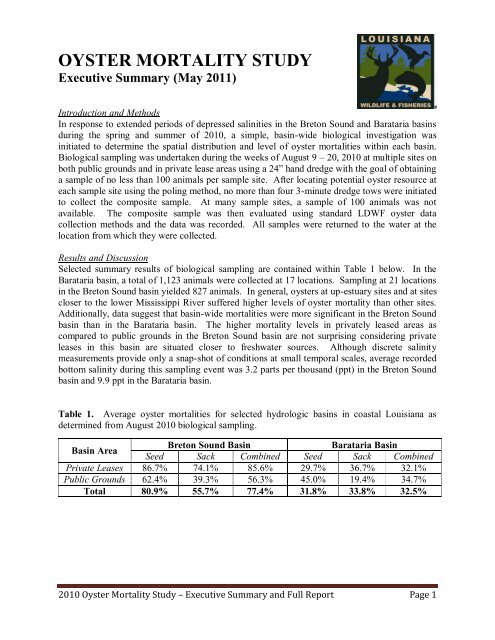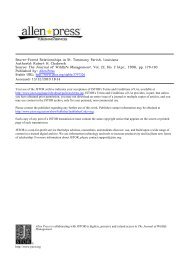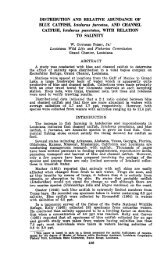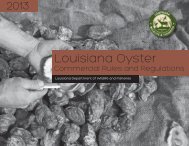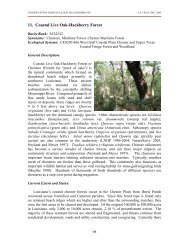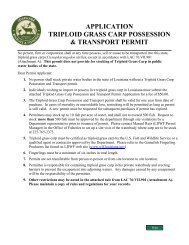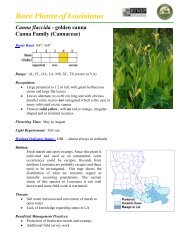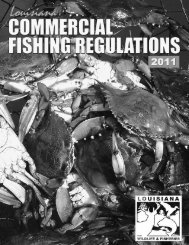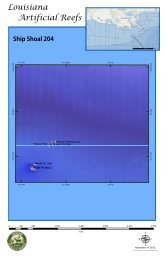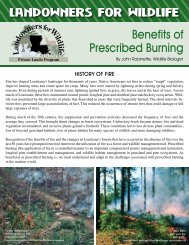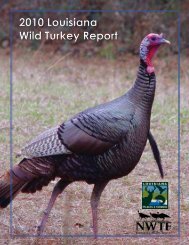Oyster Mortality Study - Louisiana Department of Wildlife and Fisheries
Oyster Mortality Study - Louisiana Department of Wildlife and Fisheries
Oyster Mortality Study - Louisiana Department of Wildlife and Fisheries
Create successful ePaper yourself
Turn your PDF publications into a flip-book with our unique Google optimized e-Paper software.
OYSTER MORTALITY STUDYExecutive Summary (May 2011)Introduction <strong>and</strong> MethodsIn response to extended periods <strong>of</strong> depressed salinities in the Breton Sound <strong>and</strong> Barataria basinsduring the spring <strong>and</strong> summer <strong>of</strong> 2010, a simple, basin-wide biological investigation wasinitiated to determine the spatial distribution <strong>and</strong> level <strong>of</strong> oyster mortalities within each basin.Biological sampling was undertaken during the weeks <strong>of</strong> August 9 – 20, 2010 at multiple sites onboth public grounds <strong>and</strong> in private lease areas using a 24” h<strong>and</strong> dredge with the goal <strong>of</strong> obtaininga sample <strong>of</strong> no less than 100 animals per sample site. After locating potential oyster resource ateach sample site using the poling method, no more than four 3-minute dredge tows were initiatedto collect the composite sample. At many sample sites, a sample <strong>of</strong> 100 animals was notavailable. The composite sample was then evaluated using st<strong>and</strong>ard LDWF oyster datacollection methods <strong>and</strong> the data was recorded. All samples were returned to the water at thelocation from which they were collected.Results <strong>and</strong> DiscussionSelected summary results <strong>of</strong> biological sampling are contained within Table 1 below. In theBarataria basin, a total <strong>of</strong> 1,123 animals were collected at 17 locations. Sampling at 21 locationsin the Breton Sound basin yielded 827 animals. In general, oysters at up-estuary sites <strong>and</strong> at sitescloser to the lower Mississippi River suffered higher levels <strong>of</strong> oyster mortality than other sites.Additionally, data suggest that basin-wide mortalities were more significant in the Breton Soundbasin than in the Barataria basin. The higher mortality levels in privately leased areas ascompared to public grounds in the Breton Sound basin are not surprising considering privateleases in this basin are situated closer to freshwater sources. Although discrete salinitymeasurements provide only a snap-shot <strong>of</strong> conditions at small temporal scales, average recordedbottom salinity during this sampling event was 3.2 parts per thous<strong>and</strong> (ppt) in the Breton Soundbasin <strong>and</strong> 9.9 ppt in the Barataria basin.Table 1. Average oyster mortalities for selected hydrologic basins in coastal <strong>Louisiana</strong> asdetermined from August 2010 biological sampling.Basin AreaBreton Sound BasinBarataria BasinSeed Sack Combined Seed Sack CombinedPrivate Leases 86.7% 74.1% 85.6% 29.7% 36.7% 32.1%Public Grounds 62.4% 39.3% 56.3% 45.0% 19.4% 34.7%Total 80.9% 55.7% 77.4% 31.8% 33.8% 32.5%2010 <strong>Oyster</strong> <strong>Mortality</strong> <strong>Study</strong> – Executive Summary <strong>and</strong> Full Report Page 1
Comprehensive Report <strong>of</strong> the2010 OYSTER MORTALITY STUDYin Breton Sound <strong>and</strong> Barataria Basins – May 2011Patrick D. BanksBiologist DCL-BLDWF <strong>Fisheries</strong> Division______________________________________________________________________________ABSTRACTIn response to extended periods <strong>of</strong> depressed salinities in the Breton Sound <strong>and</strong> Barataria basinsduring the spring <strong>and</strong> summer <strong>of</strong> 2010, a simple, basin-wide biological investigation wasinitiated to determine the spatial distribution <strong>and</strong> level <strong>of</strong> oyster mortalities within each basinduring early August 2010. Multiple locations were sampled via a 24” h<strong>and</strong> dredge <strong>and</strong> adetermination <strong>of</strong> oyster mortalities which had occurred over the approximately previous twomonths was made. In general, oyster resources at up-estuary sites <strong>and</strong> at sites closer to the lowerMississippi River suffered higher levels <strong>of</strong> mortality than other sites. Additionally, it appearsthat basin-wide mortalities were more significant in the Breton Sound basin than in the Baratariabasin. This is likely due to the more pronounced <strong>and</strong> extended period <strong>of</strong> low salinity throughoutthe Breton Sound basin. In the Barataria basin, public ground sampling showed higher mortalitylevels than on private leases <strong>and</strong> mortality <strong>of</strong> sack-size oysters (≥ 3”) was greater than seed-sizedoysters (< 3”). In the Breton Sound basin, the opposite effects were found as private lease oystermortality was higher than on public oyster seed grounds <strong>and</strong> seed oyster mortality exceededmortality levels found in sack-size oysters.INTRODUCTIONThe American oyster, Crassostrea virginica, thrives in <strong>Louisiana</strong> estuarine waters with a salinity<strong>of</strong> between five <strong>and</strong> 15 parts per thous<strong>and</strong> (ppt) (Chatry et al 1983). During times <strong>of</strong> low watertemperatures, oysters are well adapted to survive short periods <strong>of</strong> low salinities (Shumway1996). However, as water temperatures rise, oysters are less able to cope with the physiologicalstress <strong>of</strong> both high water temperatures <strong>and</strong> low salinities, <strong>and</strong> oyster mortality events <strong>of</strong>ten occur(Dugas <strong>and</strong> Perret 1975; Dugas <strong>and</strong> Roussel 1983; Dugas 1991). This biological response hasbeen well documented in coastal <strong>Louisiana</strong> in previous years – most recently in 2009 - whenlarge fresh water inputs (“freshets”) were observed in coastal <strong>Louisiana</strong> during summertimemonths. Although a definitive cause has not yet been established, it is likely this phenomenonalso occurred this summer in Bay Jaques (lower Plaquemines Parish on the west side <strong>of</strong> theMississippi River). Although LDWF marine biologists documented the Bay Jaques oystermortality event a posteriori, environmental conditions documented during field investigations <strong>of</strong>the area showed the presence <strong>of</strong> very low salinities (< 1 ppt) <strong>and</strong> high water temperatures (> 30 oC). Due to reports <strong>of</strong> oyster mortalities in both the Breton Sound <strong>and</strong> Barataria basins, <strong>and</strong> theLDWF-investigated Bay Jaques oyster mortality event, a survey <strong>of</strong> oyster resources within thesebasins was initiated.The timing <strong>of</strong> the 2010 freshwater influxes into Breton Sound <strong>and</strong> Barataria basin createdparticular challenges for oyster resources within the affected basins as water temperatures2010 <strong>Oyster</strong> <strong>Mortality</strong> <strong>Study</strong> – Executive Summary <strong>and</strong> Full Report Page 2
quickly rose above 30 o C in early June. Due to these stressful environmental conditions <strong>and</strong> thepossibility <strong>of</strong> such conditions leading to basin-wide oyster mortalities, an oyster mortality studywas conducted to document the level <strong>and</strong> spatial extent <strong>of</strong> mortalities within the Breton Sound<strong>and</strong> Barataria basins.METHODSSample Locations <strong>and</strong> Sample CollectionBiological sampling was undertaken at multiple locations throughout each basin during theweeks <strong>of</strong> August 9 – 20, 2010. In the Breton Sound basin, 21 locations were visited while 17were sampled in the Barataria basin (Figures 2 <strong>and</strong> 3, Table 1). Sample locations were selectedfor the purpose <strong>of</strong> providing robust spatial coverage <strong>of</strong> each basin <strong>and</strong> to cover both privatelyleasedareas <strong>and</strong> public grounds. Privately-leased areas are generally situated “up-estuary” in theBreton Sound basin placing them generally in lower salinity areas. The same is not necessarilytrue in the Barataria basin as leases are distributed throughout the basin across multiple salinityregimes. Public grounds in the Barataria basin are small in acreage as compared to the privateleases <strong>and</strong> <strong>of</strong>fered minimal opportunities for sampling. Conversely, public ground acreage in theBreton Sound basin is expansive <strong>and</strong> generally situated in higher salinity areas “down-estuary.”Sites were visited, reconnaissance poling (= probing <strong>of</strong> the water bottoms with a PVC or canepole) was conducted until exposed shell resources were located, <strong>and</strong> then dredge sampling wasconducted. Sampling was completed using a st<strong>and</strong>ard 24” h<strong>and</strong> dredge towed behind the vesselfor three minutes per tow with the goal <strong>of</strong> obtaining no less than 100 animals per location. Thecomposite sample <strong>of</strong> animals consisted <strong>of</strong> any combination <strong>of</strong> live <strong>and</strong>/or dead seed-size <strong>and</strong>/ormarket-size animals. Due to time constraints, no more than four dredge tows were attempted persample location <strong>and</strong> most locations yielded less than the target <strong>of</strong> 100 animals. <strong>Oyster</strong>s <strong>and</strong> shellmaterial from each dredge tow were combined to form one composite sample per location. Eachcomposite sample was evaluated, data was collected, <strong>and</strong> the sample was returned to the water atthe sample location. Coordinate information for each sample station is provided in Table 1.Data Collection <strong>and</strong> AnalysisFollowing collection <strong>of</strong> the composite sample at each location, the sample was photographed <strong>and</strong>systematically evaluated. Data on mortality, size distribution <strong>and</strong> spat set were recorded as pernormal LDWF oyster sampling protocols where animals (both live <strong>and</strong> dead) within the sampleare measured to the nearest millimeter <strong>and</strong> recorded in five-millimeter work groups. Spat oystermortality data (spat = 1 to 24 mm) was also recorded, although small, dead spat are <strong>of</strong>tentimesdifficult to identify <strong>and</strong> thus accurate estimates <strong>of</strong> spat mortality are nearly impossible.However, data collected on spat mortality likely represent the minimum mortality for this oystersize class. <strong>Mortality</strong> was determined from the composite sample <strong>of</strong> collected animals bydividing the total number <strong>of</strong> live <strong>and</strong> dead oysters by the total number <strong>of</strong> dead oysters withineach general size category (spat, seed, sack). In some cases, data from multiple size classes werecombined (i.e. seed <strong>and</strong> sack-sized oysters). Hydrologic data (i.e. salinity, temperature) at eachlocation was also recorded.Collected data was compiled in spreadsheet form with each animal from each basin treated as areplicate rather than using sample location as the replicate. This composite method allows forgreater resolution <strong>of</strong> the mortality estimate with less variance than taking the average mortality<strong>of</strong> all the sample locations. Therefore, a sample location yielding 50% mortality based on only,for example, two collected animals would not be treated as equal to a sample location that2010 <strong>Oyster</strong> <strong>Mortality</strong> <strong>Study</strong> – Executive Summary <strong>and</strong> Full Report Page 3
yielded 50% mortality based on 100 animals. Because total mortality was calculated using acomposite <strong>of</strong> all animals collected, <strong>and</strong> not based on the average mortality using replicatestations, statistical comparisons <strong>of</strong> mortality estimates cannot be made. Caution must be taken infocusing on site-specific mortality estimates as the sample size at each sample site varied greatly.RESULTSBreton Sound BasinA total <strong>of</strong> 827 animals were collected in the Breton Sound basin yielding an overall mortalityestimate <strong>of</strong> 77.4%. Sampling at four <strong>of</strong> the 21 sites yielded 10 animals or less <strong>and</strong> the averagecatch per site was 39 animals (combined live <strong>and</strong> dead) (Table 1). Mortalities at sample siteswithin the privately leased areas showed increased mortality as compared to sites in public oystergrounds as 85.6% <strong>of</strong> all oysters collected in the privately leased areas were dead compared to56.3% on public grounds. Seed oysters also showed differential mortality (80.9%) as comparedto market-size (sack) oysters (55.7%) (Figure 1), but were more numerous in samples,accounting for over 86% <strong>of</strong> the animals collected (excluding spat). Spat mortality estimateswere the highest <strong>of</strong> all size-classes at 93%. In general, sample locations at “up-estuary”locations suffered higher mortalities than those locations in the “down-estuary” area. Discretesalinity measurements recorded during sampling averaged 3.2 (± 4.3) parts per thous<strong>and</strong> (ppt).Barataria Bay BasinDredge sampling in the Barataria basin yielded 1,123 animals with seed oysters accounting for65.2% <strong>of</strong> the samples (excluding spat). Sampling at each site resulted in an average catch <strong>of</strong> 66animals per station <strong>and</strong> only one sample location in this basin yielded 10 animals or less (Table1). Total basin-wide mortality was estimated at 32.5% with mortalities being fairly evenlydistributed across public grounds <strong>and</strong> private leases, <strong>and</strong> between oyster size categories. Nearlyidentical estimates <strong>of</strong> mortality were generated from public ground sample locations (34.7%) asfrom private lease areas (32.1%) (Figure 1). Market-size (sack) oysters suffered approximately33.8% mortality while seed oysters experience 31.8% mortality. Spat oysters showedapproximately 49% mortality. “Up-estuary” locations experienced more mortality than “downestuary”sites, although one “down-estuary” location (Bay Jaques) which is situated very near themouth <strong>of</strong> the Mississippi River showed 100% mortality (94 seed <strong>and</strong> sack animals werecollected). Discrete salinity measurements recorded during sampling averaged 9.9 (± 7.9) ppt.DISCUSSIONLimited oyster sampling within the Breton Sound <strong>and</strong> Barataria basins during August 2010showed pronounced oyster mortalities within each area. This mortality event coincided with anextended period <strong>of</strong> low salinity <strong>and</strong> high water temperature, <strong>and</strong> was similar in nature todocumented oyster mortality events in past years (Dugas <strong>and</strong> Perret 1975; Dugas <strong>and</strong> Roussel1983; Dugas 1991). Based on discrete salinity measurements recorded during sampling, it is notsurprising that the Breton Sound basin suffered more <strong>of</strong> a mortality signal than did the Baratariabasin. Breton Sound basin mortalities appeared to follow a more consistent general southeast tonorthwest trend <strong>of</strong> increasing mortalities (Figure 2). In this basin, public grounds are located tothe southeast (“down-estuary”) while private leases are generally located to the northwest (“upestuary)<strong>and</strong> data indicate that oysters located on private leases suffered significantly moremortality than did animals on public grounds (Figure 1). In general, public ground reefs arelocated in areas farther away from freshwater sources as compared to private leases in the BretonSound basin. Due to this spatial component, it is expected that private lease oysters in this basin2010 <strong>Oyster</strong> <strong>Mortality</strong> <strong>Study</strong> – Executive Summary <strong>and</strong> Full Report Page 4
would respond detrimentally to depressed salinities over extended periods during times <strong>of</strong> highwater temperature.While significant mortalities were documented in the Barataria basin, they were localized in theextreme northern <strong>and</strong> southeastern parts <strong>of</strong> the basin (Figure 3), but did not show any significanttrends with respect to oyster size. Additionally, almost no difference in mortality was observedin the Barataria basin among oysters located on private leases versus public grounds (Figure 1).This is an expected outcome considering that public grounds <strong>and</strong> private leases are both situatedthroughout the spatial extent <strong>of</strong> the basin.It should be noted that additional sampling at each location resulting in the collection <strong>of</strong> moreanimals would have bolstered the data set. As time constraints prohibited collection <strong>of</strong> morethan four dredge tows per site, small sample sizes at many stations resulted. These small samplesizes precluded stations from being used as replicates in this study, thereby inhibiting pair-wisestatistical comparison <strong>of</strong> means. Caution should be taken when attempting to compare sitespecificmortality as differential sample sizes among sites may influence such comparison.Regardless, clear indications <strong>of</strong> oyster mortality were documented, especially in privately-leasedareas <strong>of</strong> the Breton Sound basin.ACKNOWLEGEMENTSThis project could not have been accomplished without the hard work <strong>of</strong> dedicated LDWFemployees. Thanks to Chris Baker, Ty Lindsey, Paul Lang, Susanna Brian, Denise Kinsey, RoyGiardina, <strong>and</strong> Felixcia Blanchard.REFERENCESChatry, M. R., R. J. Dugas, K. A. Easley. 1983. Optimum salinity regime for oyster productionon <strong>Louisiana</strong>’s state seed grounds. Contributions in Marine Science. 26:81-94.Dugas, R. J. <strong>and</strong> W. S. Perret. 1975. The effects <strong>of</strong> 1973 spring floodwaters on oysterpopulations in <strong>Louisiana</strong>. Proceedings <strong>of</strong> the 29 th Annual Conference <strong>of</strong> the SoutheasternAssociation <strong>of</strong> Game <strong>and</strong> Fish Commissioners. Pp. 208-214.Dugas, R. J. <strong>and</strong> J. Roussel. 1983. Report on oyster mortalities in <strong>Louisiana</strong> as a result <strong>of</strong>excessive freshwater intrusion – 1983. <strong>Louisiana</strong> <strong>Department</strong> <strong>of</strong> <strong>Wildlife</strong> <strong>and</strong> <strong>Fisheries</strong>report. 65 pp.Dugas, R. J. 1991. Report on oyster mortalities in <strong>Louisiana</strong> as a result <strong>of</strong> excessive freshwaterintrusion – 1991. <strong>Louisiana</strong> <strong>Department</strong> <strong>of</strong> <strong>Wildlife</strong> <strong>and</strong> <strong>Fisheries</strong> report. 20 pp.Shumway, S. 1996. Natural environmental factors. Chapter 13 in Kennedy, V. S., R. I. E.Newell, <strong>and</strong> A. F. Eble (eds.) The Eastern <strong>Oyster</strong>: Crassostrea virginica. Pp. 467-513.2010 <strong>Oyster</strong> <strong>Mortality</strong> <strong>Study</strong> – Executive Summary <strong>and</strong> Full Report Page 5
% <strong>Mortality</strong> (seed <strong>and</strong> market combined)90.0%80.0%70.0%Private LeasesPublic Grounds60.0%Combined50.0%40.0%30.0%20.0%10.0%0.0%Breton Sound BasinBarataria BasinFigure 1. Estimated total mortality in the Breton Sound <strong>and</strong> Barataria basins based on August2010 dredge sampling.Figure 2. Site-specific oyster mortality estimates for the Breton Sound basin based on August2010 dredge sampling. Percent mortality represents seed-size <strong>and</strong> market-size oysterscombined.2010 <strong>Oyster</strong> <strong>Mortality</strong> <strong>Study</strong> – Executive Summary <strong>and</strong> Full Report Page 6
Figure 3. Site-specific oyster mortality estimates in the Barataria basin based on August 2010 dredgesampling. Percent mortality figures represent seed-size <strong>and</strong> market-size oysters combined.2010 <strong>Oyster</strong> <strong>Mortality</strong> <strong>Study</strong> – Executive Summary <strong>and</strong> Full Report Page 7
Table 1. Sample site locations for 2010 oyster mortality study in the Breton Sound(CSA 2) <strong>and</strong> Barataria (CSA 3) basins. Coordinates listed are in North AmericanDatum (NAD) 1983.CSA Station Name Latitude Longitude # <strong>of</strong> Animals Collected*2 Bay Shallow 29.6816 89.7149 512 Bayou Dominique 29.6260 89.6742 122 Four Horse Lake 29.6981 89.7067 1432 Francois Martin 29.5942 89.6901 552 Fucich Bayou 29.5040 89.6429 512 Lost Flat Bay 29.6370 89.7106 502 Oak River 29.6481 89.6674 102 Thorntree Bay 29.6097 89.7427 532 American Bay 29.5679 89.6824 502 Bay Fortuna 29.6697 89.5168 332 Bay Gardene 29.6008 89.6307 532 Bottle Bayou 29.6830 89.6304 522 False River 29.6564 89.7414 392 Horseshoe Reef 29.5878 89.4899 02 Lake Campo 29.6448 89.6434 512 Pelican Isl<strong>and</strong> 29.4969 89.5330 212 Snake Isl<strong>and</strong> 29.6245 89.5661 92 Stone Isl<strong>and</strong> 29.5785 89.5390 502 Triple Pass (Bay Gardene) 29.5661 89.6486 132 Bay Crabe 29.5480 89.5645 22 Sunrise Point 29.4794 89.5688 293 Bastian Bay 29.3247 89.6465 1043 Bay Adams 29.3698 89.6320 1433 Bay Batiste 29.4315 89.8464 633 Bay Diego (south <strong>of</strong>) 29.2737 90.1363 343 Bay Jacques 29.2886 89.5145 943 Bay Pom de Ore 29.3302 89.5795 1043 Bay Rambo (north <strong>of</strong>) 29.3376 90.1275 1073 Bay San Bois 29.4564 89.7800 923 Gr<strong>and</strong> Bayou 29.4536 90.0426 713 Lake Gr<strong>and</strong> Ecaille 29.3745 89.8219 223 Lower Wilkinson Bay 29.4629 89.9148 973 Upper Wilkinson Bay 29.4876 89.9204 153 Barataria Bay 29.3302 89.9401 03 Bayou St. Denis 29.4913 90.0374 123 Gr<strong>and</strong> Terre Intertidal Reef 29.2769 89.9423 373 North Hackberry Bay 29.4181 90.0326 903 South Hackberry Bay 29.3900 90.0516 28*Seed <strong>and</strong> sack-sized oysters combined2010 <strong>Oyster</strong> <strong>Mortality</strong> <strong>Study</strong> – Executive Summary <strong>and</strong> Full Report Page 8


